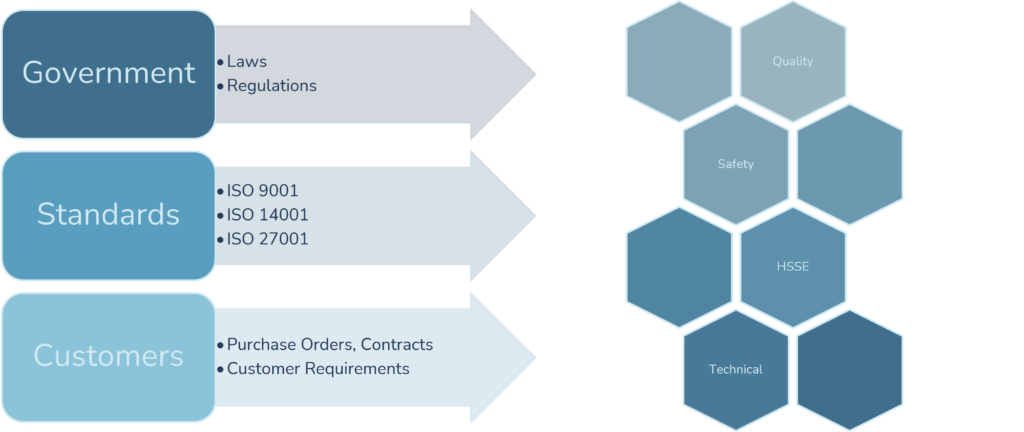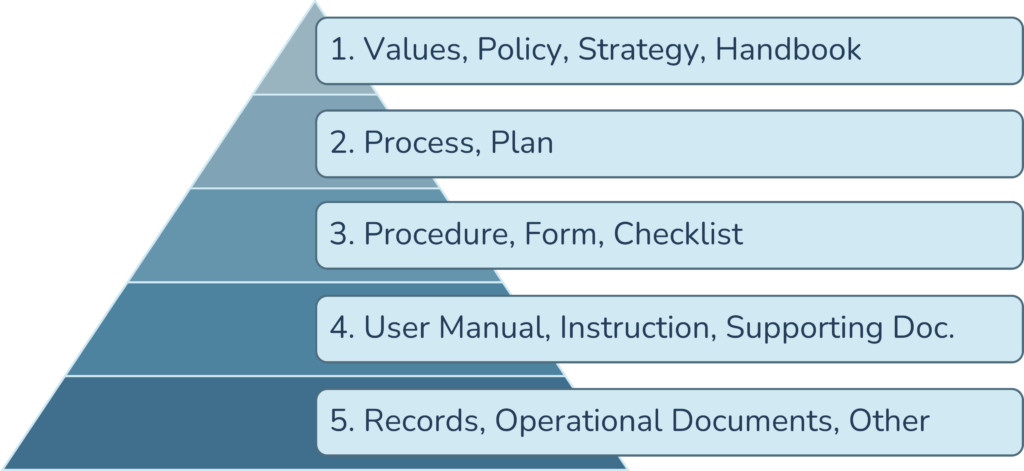Structuring documents effectively in an organization is crucial for maintaining efficiency, ensuring compliance, and promoting collaboration. Start by differentiating into
| Requirement Documents | Requirement Documents are laws, regulations and standards on which the organization has limited to no influence. |
| Management System Documents | Management System Documents organize external requirements into different topics and responsibilities and form internal requirements and supporting documents to achieve compliance and an effective workflow in the organization. |
| Operational Documents | Operational documents, usually project or product documents. And other documents that do not fall under the two levels above. |
Requirement Documents
Requirements derive from different sources and must be assessed for applicability, compliance and monitored for change. To be compliant to the requirements in those requirement documents they must be broken down and assigned to one or more disciplines.

Management System Documents
Documents in the management system are structured hierarchical where each document may lead to one or more documents on the lower levels. Each document shall take the requirement documents into consideration break down the requirements to ensure that they will be implemented at the appropriate level and discipline. Make sure to use references to all applicable requirement documents.
NOTE: Each organization can decide to draw the line between management system documents and operational documents either between level 3 and 4 or level 4 and 5 depending on the tools and internal structures.

1. Values, Policy, Strategy, Handbook
Break down requirements from governing documents into different disciplines (used HR, HMS, Safety, Security, Quality) and define responsibilities, authorities and interfaces. Policies, goals and plans must consider those requirements and are decided upon and approved by owners and top management. Handbooks are of the kind Quality Handbook, HMS Handbook and not to be confused with Equipment Handbook. They can also give guidance on how to achieve visions and goals.
Examples: Code of Conduct (CoC), Privacy policy, HMS handbook, Employee handbook, Quality Management Manual.
2. Process, Plan
Build the framework of operations. Processes usually are a collection of documents which are used to perform a specific task. These define Who, What, When at high level. Plans can be used to perform operations and define interactions in between processes (example Project Plan). Plans can not override documents in the Management System.
Examples: Production Process, Maintenance Process, Strategic Plan, Project Plan, Audit Program
3. Procedure, Forms, Checklist
A procedure defines roles and responsibilities, inputs and results and the overall flow and other information to ensure compliance, consistent results and repeatability. Procedures should not go into too much detail e.g. describing how to use tools, software etc. If detailing is needed it should be done at level 4 documents.
Forms ensure that required information is provided in a correct format.
Checklists ensure that critical steps are performed (in the right order).
A filled-out forms or checklist could be used as record (see Level 5).
Forms and checklist can also be realized as “documented information” in digital forms / checklists or in digital tools .
Example: Procedure for incoming inspection, Procedure for nonconformance processing, Supplier evaluation form, Audit checklist template, Safe Job Analysis (SJA), Customer survey (Digital)
4. User Manual, Instruction, Supporting Documents
User Manuals, Instructions etc. give a detailed step by step description. The organization should decide whether those documents are a part of the Management System or if they are part of the operational documents.
Examples: Instructions for assembly of product [product name], Instruction for performing Factory, Acceptance Test (FAT), User Manual for ERP Software
Records, Operational Documents, Other
While records are not formally placed in the management system they are placed in this overview as they play an essential role in documenting a functional management system. Records may refer to all documents that are generated during the execution of processes and tasks. Filled out checklists, forms or data stored in different places / software serve as records that the activity or process is performed according to plan. A record might also document why and how the process was performed differently (nonconformance reports). Details on what records are to be stored; including where how long an who is responsible for storing will be detailed later.
Examples: Minutes of Meeting, Risk Analysis Matrix, Nonconformity Register, Certificate of Conformity (CoC), Calibration records
Operational Documents
Operational documents are essential tools used in day-to-day business activities, distinct from formal management system documentation. These documents provide practical, detailed guidance and information to facilitate the execution of specific tasks, projects, or operations within an organization. Examples include product drawings, technical blueprints, production schedules, training materials, and project plans. They are typically dynamic and subject to frequent updates to reflect changes in operational needs, project timelines, or product specifications.
Unlike management system documents, which define high-level policies, procedures, and standards, operational documents are focused on the practical implementation of these frameworks. They enable teams to carry out their responsibilities effectively by offering clear, actionable instructions tailored to specific objectives. While they may not be subject to the same rigorous control as formal system documentation, maintaining accuracy and accessibility of operational documents is crucial to ensure consistency, efficiency, and quality in everyday operations.